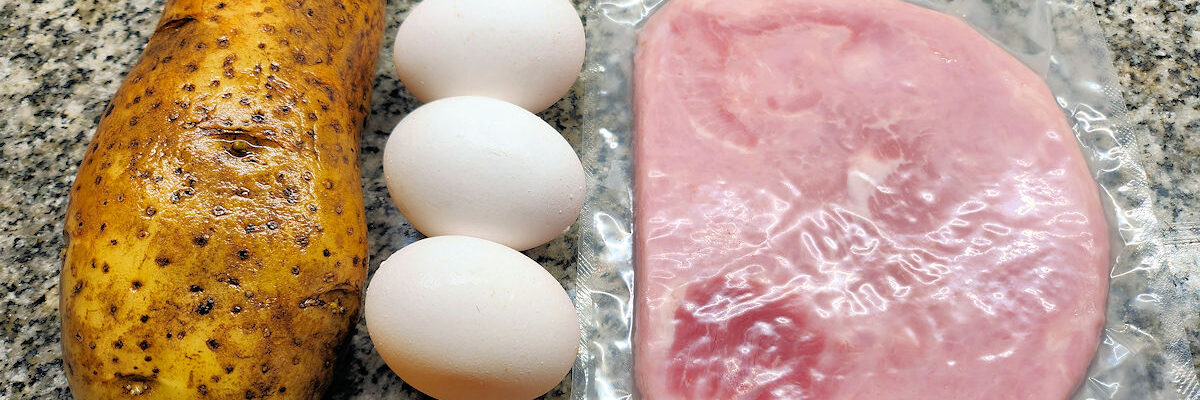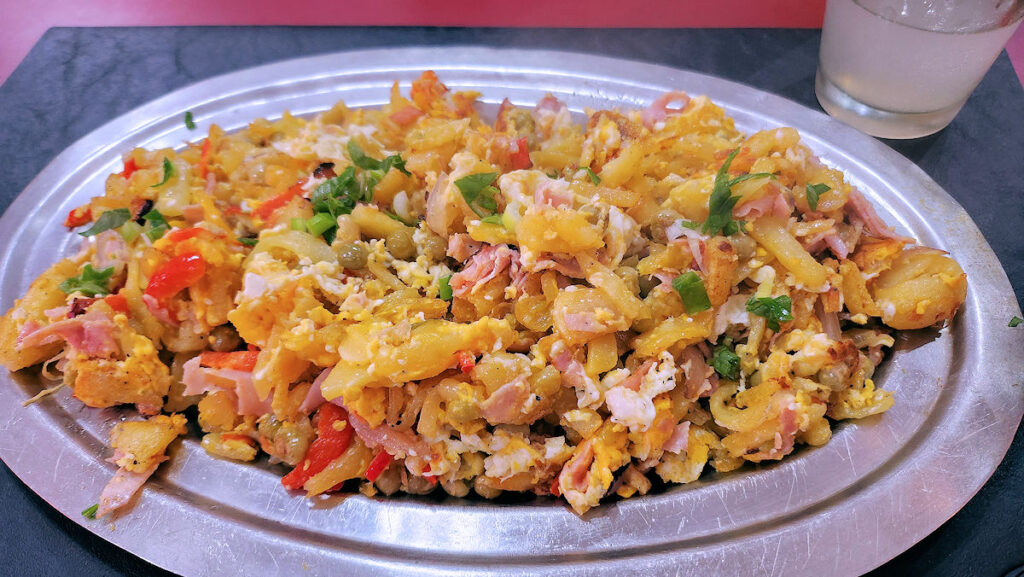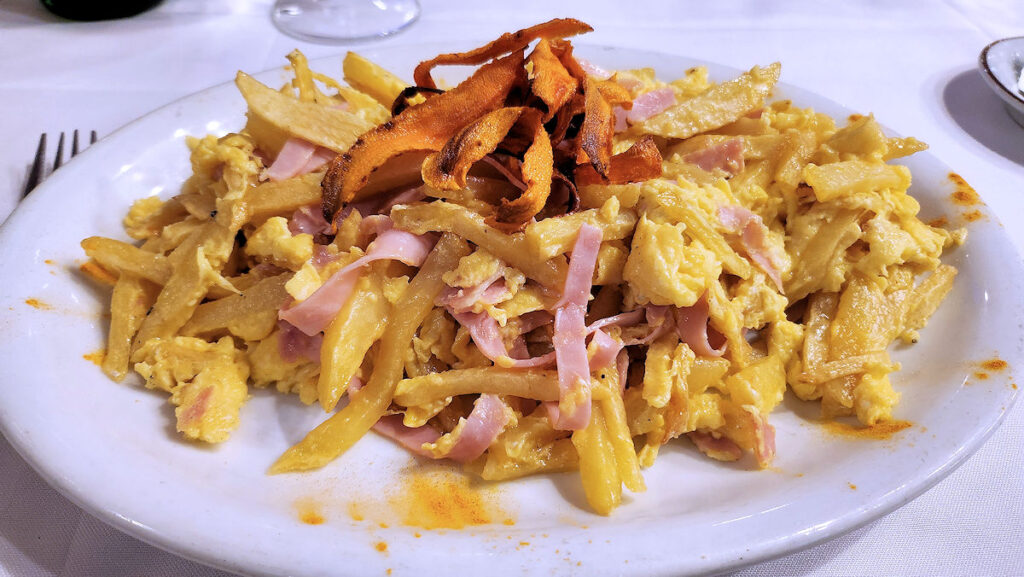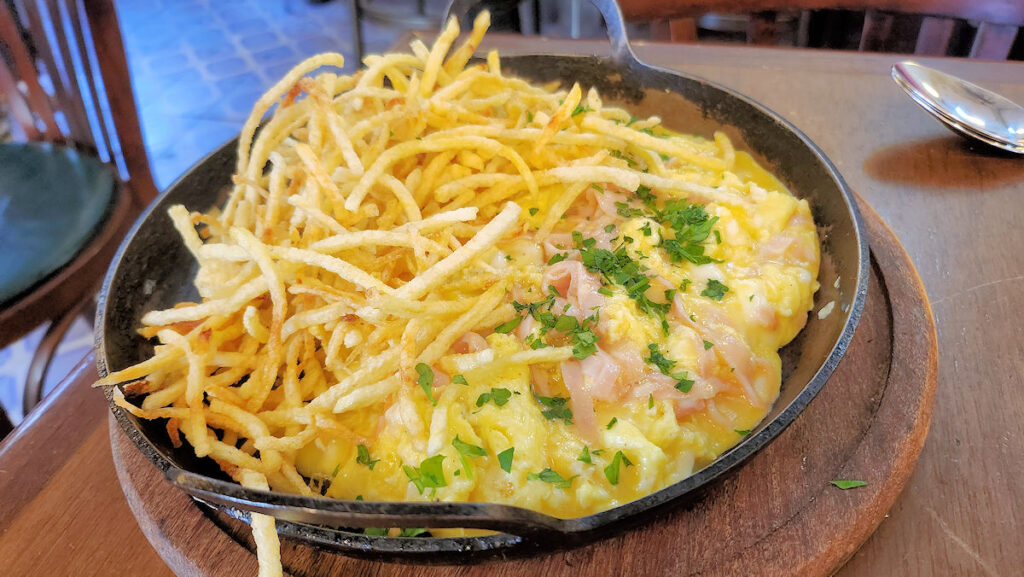Some thirteen years ago I first wrote in detail about the iconic Argentine dish, the Revuelto Gramajo. Over the years, I’ve continued to try various versions of the dish, and also, on occasion, dip into its history. And, over time, more details have made their way to the internet, from more and more reliable sources. There’s pretty solid evidence now that some iteration of “version 4”, the Arturo Gramajo story is the correct one. Some alteration to it – it appears it didn’t take place in Paris, but in Buenos Aires, and combining it with version 3, likely at El Club del Progreso. That actually makes a bit more sense, as it’s likely that his family were members of the club, and it makes the rapid spread of the dish in the city more believable.
I’ve also delved into the actual recipe a bit more. In the comments below my original post, and in posts since, there have been objections to various versions that included ingredients that purists say shouldn’t be there, or approaches to the recipe that don’t fit their view of the dish. According to the self-important folk at the Grupo Gramajo, which appears to be about two dozen older guys who like to eat out together now and again, the recipe is set in stone. Yet, as best I can tell, there is only one place in the city that makes it following that recipe (and it’s not even the supposed birthplace at El Club del Progreso), which limits where they might go out to eat it prepared correctly.
The gospel for the recipe is a simple scramble of eggs – never whisked, just moved around in the pan so that you have streaks of white and yellow. Seasoned with salt and a small amount of pepper, and with a julienne of cooked ham. On the side, never mixed in, and never on top, should be papas pays, or, crispy shoestring potatoes, lightly salted. And that’s it. Now, one caveat occurs to me. These days everyone, including the place that does it “right” uses thin sliced lunchmeat ham. But packaged, thin sliced ham of that sort didn’t exist in the mid 1800s, so it’s more likely that this was made from a julienne of an actual cooked leg of ham rather than the bright pink stuff we’re so used to. Even if they’d used deli type ham, which did exist, it still would have been different. I’d like to see someone make this dish using high quality ham in the mix rather than supermarket cold-cuts.
So, on to a trio I’ve tried recently! I’m going to start with what I’d assert is the most common version seen in bodegones. It’s mostly french fries, somewhat broken up by the scrambling process, and not crispy – often a bit oil soaked. Basically they’re stir-fried with a little bit of egg, just enough to kind of coat them with bits, and then canned peas and roasted peppers are tossed into the mix. You can find this version at probably 3/4 of the bodegones in the city, and most of the remaining quarter simply don’t offer the dish.
This particular one is from Bodegón A Mis Viejos, Pichincha 2001, in Parque Patricios. It shows up on more than one list of “favorite revuelto gramajos” in the city. It’s like eating a huge pile of loaded french fries – tossed with some hard cooked egg, canned peas, and some diced red bell pepper. For the style, it’s decent – not oily, though desperately in need of seasoning – no salt or pepper used in the making of it, and my waitress brought both of those to the table with the dish, making a point that I’d need them. It’s a bit much for one person, and that’s common when this dish is served, as it’s more often a shared appetizer or side dish, but probably not enough for two people unless you’re having something else. Pretty reasonable at 6100 pesos, currently about $4.50.
Interestingly, I was watching an interview with Alejandro Maglione, the former “president” of the Grupo Gramajo, and a well known gastronomic journalist. He passed away about two years ago. The interview was held at El Globo, Av. Hipólito Yrigoyen 1199, Monserrat. He and the interviewer were having coffee and chatting about the dish. When it was proposed that they try the dish during the interview he more or less waved off the idea, and the interviewer later came back and did a whole “in the kitchen” video segment and then trying the dish. For a purist, this one just wouldn’t fit the bill – again, french fries instead of shoestrings, not crispy, tossed with the egg and ham – and the egg has clearly been whisked, since it’s all evenly colored. No additions are made, unless you call a few also not crispy strips of fried sweet potato atop an addition. To their credit, the dish is well seasoned with salt, though I like a bit more pepper than they put on it, and more was provided. This one is an easy portion for two, and comes in at 9700 pesos, or just a touch over $7.
So, finally we get to the “real” version. This is about as dead-on as you can get. It’s a soft scramble, not hard, with ham, and the egg was clearly left separate at the start of the cook. It’s served on the side of a huge mound of beautifully crisp shoestring potatoes. I suppose you could call the sprinkle of parsley an addition, but it probably wouldn’t even bother a purist. This plate is offered up at Los Galgos, Av. Callao 501, San Nicolás. It’s a whopping portion – intended for two as a meal – and runs 14500 pesos, just shy of $11 these days. The dish has a place of honor on the menu, and is, I think, the only place that Grupo Gramajo has given an award to for its authenticity. They also offer a version made with mushrooms instead of ham for the veggie folk.
Look for a detailed “Best of” this dish over on my Substack column, coming up in the next day or two.



